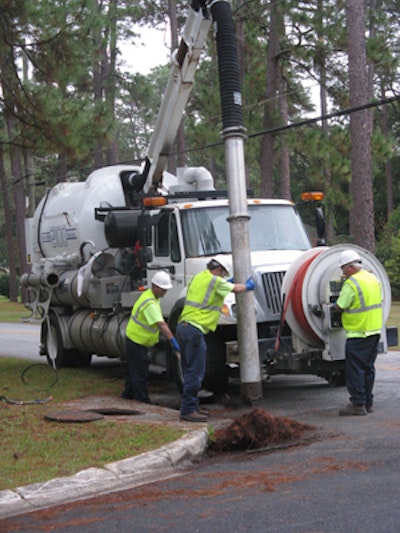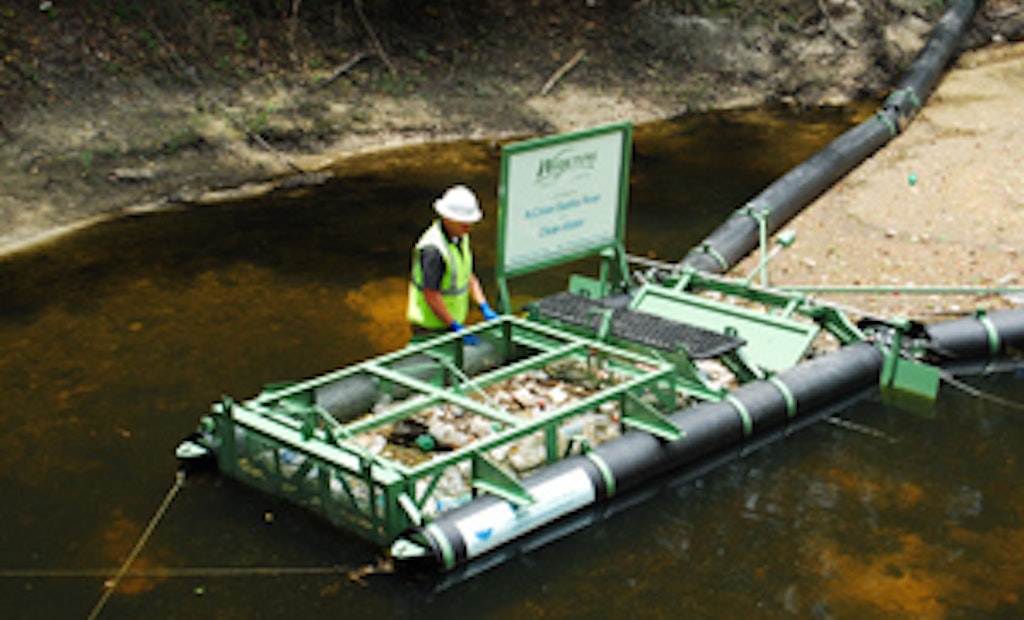Interested in Stormwater?
Get Stormwater articles, news and videos right in your inbox! Sign up now.
Stormwater + Get AlertsWaycross, a Georgia city of 15,000 people, is too small to come under MS4 stormwater permit coverage, yet it is one of few state municipalities its size to adopt an aggressive stormwater management ordinance.
It’s all because of topography. Waycross, the largest city on the Satilla River, was built on a wetland creek system separated by sugar sand hills. Man-made canals dewatered the creeks, enabling the land to be developed. The present-day Waycross City Drainage Canal, a Satilla River tributary, runs down the center of the old system, draining more than 8,000 acres of dense urban development.
Another topographical feature affecting runoff is the Eastern Subcontinental Divide. Rain falling north of it reaches the Atlantic Ocean via the Satilla River. The southern fringe of the city, four miles from the Okefenokee Swamp, lies south of the ridgeline. Water there drains to the Gulf of Mexico via the swamp and Suwannee River.
The city, faced with $3 million worth of stormwater projects and an annual stormwater budget of $329,000, advances the work through partnerships with developers and cooperation between departments.
Flood control challenges
The Satilla River is critical to protect, as it is considered a wild and pristine river. It is also a habitat for redbreast sunfish and one of Georgia’s few blackwater rivers — a deep, slow-moving channel flowing through forested swamps and wetlands.
The 27-mile canal system flows from all directions throughout Waycross. Most headwaters begin as natural ditches with vegetative buffers, then become part of the city’s open and piped stormwater conveyance system. Two major arteries converge into one large canal behind the wastewater treatment plant on the city’s east side. Main canals are 40 to 80 feet wide and 6 to 8 feet deep.
Waycross has one of the largest rail classification yards in the country, with hundreds of miles of parallel track. As the yard developed, workers redirected channels draining to the Suwannee River to the city’s canal system, diminishing its capacity.
As a retail hub for southeastern Georgia, Waycross has the largest concentration of stores within a 50-mile radius. City and Ware County officials, worried about how the ongoing and anticipated development would affect flood control, conducted a study of the conveyance system and canals in 1994. They inventoried structures, analyzing them for size and ability to handle flows during different rain events.
“A significant number were undersized for even a 10-year event,” says city engineer Frank Baugh, P.E., of the Engineering Division. “The study showed that development, with its topographical changes, would compound flooding issues. Our goal then became to prevent progressive deterioration of the drainage system and find a way to control future growth.”
Logistics thwarted those efforts. Outside the city limits is the Doughnut, an urban fringe with significant development. After the study, the city and county were supposed to adopt a self-imposed comprehensive storm drainage ordinance. The city did in 2000, but the county did not, and that enabled contractors to avoid permit requirements.
Beginning in 2001, droughts mitigated flood control challenges, but heavy rains in recent years reopened city-county collaboration. “We’re discussing pooling our resources and retaining a consultant to refine the city’s stormwater management ordinance based on our 10 years of experience,” says Baugh. “The consultant will then draft the county’s ordinance so it complements ours, and we’ll both adopt it.”
Caring for canals
Baugh expects further cooperation with the county to investigate what is causing channel blockages in densely vegetated, swampy areas that are difficult to penetrate.
“We can’t send in men until the weather cools off and the insects slow down,” says Baugh. “We also want to partner with the county to study the dynamics of drainage at the rail yard. That will establish which channels to route back to the Suwannee River, taking pressure off the canal system.”
Public works crews mow canal banks in populated areas. They also maintain the city’s 5-acre detention basin, built to mitigate flooding caused by runoff from upstream developments and a residential area. An excavator operator and dump truck drivers repair cave-ins and washouts and remove brush and debris from the mouths of culverts and pipes. The work takes 480 man-hours per year. The city hires licensed contractors to eradicate brush within the canal footprint by applying herbicides.
Baugh has four workers who respond to complaints about the conveyance system. “We had a dedicated cleaning crew, but lost it six years ago to attrition,” he says. The men have a backhoe and Vactor 2100 PD combination sewer cleaner. When needed, they borrow a camera from the sewer and water department.
One of the toughest maintenance challenges is highly acidic soil corroding the 18- to 72-inch corrugated metal drainpipes under streets. The majority of the city’s capital projects are replacing failed sections with concrete or plastic pipe when the streets cave in. “We open-cut because it is more economical than trenchless technology and most repairs are in residential areas with low-volume traffic,” says Baugh.
One such residential area with a failing 460-foot-long segment of 72-inch piped canal is causing a lot of head scratching. “We’re not quite sure how to tackle it because open-cut repair of this magnitude is cost prohibitive,” says Baugh. The city is making interim grout repairs and exploring in situ repair options.
Trapping trash
Beyond canal care, the city faces a challenge with trash washing into the system during rain events. For years, litter discharging into the Satilla River from Morningside Creek, a primary outflow from the Waycross City Drainage Canal system, collected downstream in rafts of trash going on for 10 to 15 miles.
Although the city had no legal obligation, it wanted to be a good steward. Periodically, the wastewater treatment plant staff voluntarily cleaned up the canal below the last confluence point near the facility, but their efforts intercepted only a fraction of the litter. As the volume increased, trash became the prime concern of anglers, residents, and Gordon Rogers, then the Satilla Riverkeeper.
“Having worked closely with Gordon on other water-quality issues, we sought his help,” says Baugh. He told the city staff about the Bandalong Litter Trap from Storm Water Systems.
The trap has two high-density polyethylene booms that provide flotation, a maintenance platform, and aluminum and stainless steel hardware and braces. The booms, spanning the 80-foot-wide channel in a vee, direct litter into an aluminum basket that when full is lifted with a truck-mounted crane and emptied into a container.
Chains connected to the cables that tension the booms allow them to float. The booms rise and fall as water levels fluctuate from one to two feet deep in summer and from 10 to 12 feet deep in late winter. In one day, Storm Water Systems installed the device below the confluence and a half mile upstream from the Satilla River.
“The area doesn’t lend itself to a bar screen, which would have required a cost-prohibitive capital project and an Army Corps of Engineers permit due to excessive encroachment into the floodway,” says Baugh. “The trap anchors to the stream bank with guy wires cemented into the ground. There is minimal disturbance.”
From May through September 2010, the city removed 73 cubic yards of litter. Based on annual rainfall of 48 inches, Baugh estimates the device will catch 150 cubic yards of trash per year. The cost of the project, including extension of a service road, was $127,000. It should help posture Waycross for compliance when it falls under MS4 permitting. The Georgia Environmental Facilities Authority provided a loan for the work.
By agreement
Partnerships remain the city’s strongest stormwater management tool. A developer envisioned building a 60-acre strip mall on the southeast side of the Doughnut. The land had remained undeveloped because years ago the city had routed runoff from numerous upstream developments onto the property.
“We reached an agreement,” says Baugh. “The developer would construct an 8-acre retention pond with ample capacity to handle upstream development, and the city would repay his expenditure over 28 years and take possession of the pond. He also built 2-acre detention basins to his out-parcel tracts — the only completed part of the strip mall due to the economy.”
The city’s biggest stormwater challenge remains flood control and financing of projects. “We’ve implemented a water-sewer rate study and did increase our millage rate in 2010,” says Baugh. When Waycross falls under Phase II MS4 permit coverage — and the state says it is coming — the city will consider levying a stormwater utility fee to finance those capital projects.










